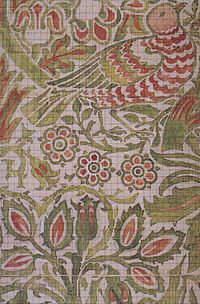
Back Disseny tèxtil Catalan Textilní vzor Czech Textildesign German Diseño textil Spanish Tekstiilidisain Estonian طراحی پارچه Persian Design textile French Textiltervezés Hungarian テキスタイルデザイナー Japanese การออกแบบสิ่งทอ Thai
This article may require copy editing for grammar, style, cohesion, tone, or spelling. (December 2023) |
Textile design, also known as textile geometry, is the creative and technical process by which thread or yarn fibers are interlaced to form a piece of cloth or fabric, which is subsequently printed upon or otherwise adorned.[1] Textile design is further broken down into three major disciplines: printed textile design, woven textile design, and mixed media textile design. Each uses different methods to produce a fabric for variable uses and markets. Textile design as an industry is involved in other disciplines such as fashion, interior design, and fine arts.[2][3]

- ^ Clarke, Simon, 1963- (2011). "Introduction". Textile design. London [England]. ISBN 978-1-78539-200-9. OCLC 908338301.
{{cite book}}: CS1 maint: location missing publisher (link) CS1 maint: multiple names: authors list (link) CS1 maint: numeric names: authors list (link) - ^ Briggs-Goode, A. (Amanda). "Introduction". Printed textile design. London. ISBN 978-1-78067-403-2. OCLC 898176484.
- ^ Russell, Alex (2016). "Introduction". The fundamentals of printed textile design. [London]. ISBN 978-1-4742-1853-5. OCLC 1053941237.
{{cite book}}: CS1 maint: location missing publisher (link)
© MMXXIII Rich X Search. We shall prevail. All rights reserved. Rich X Search